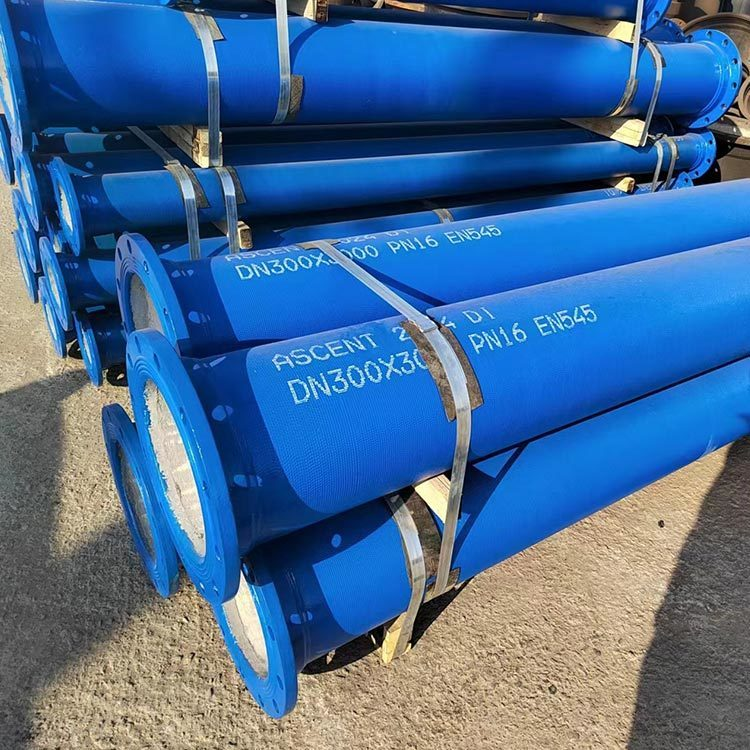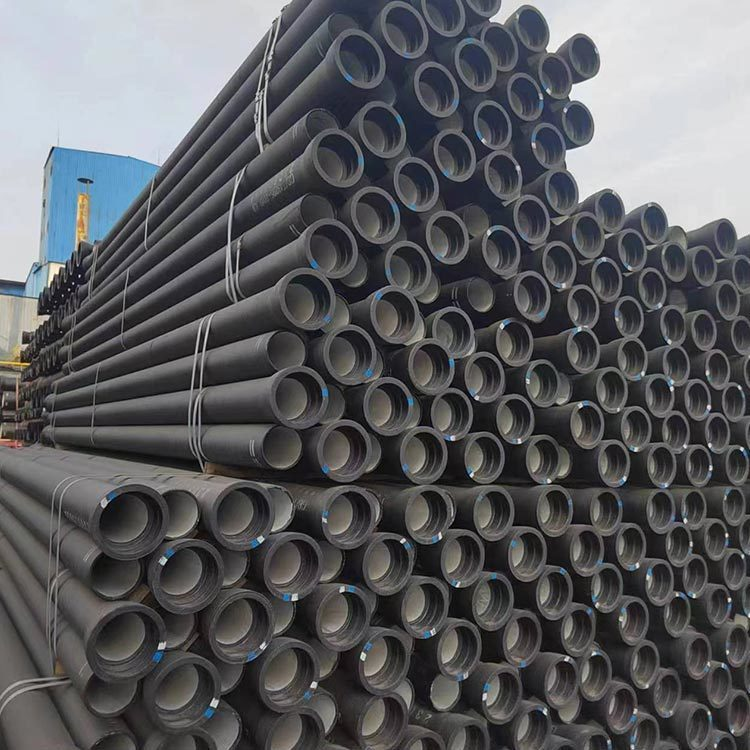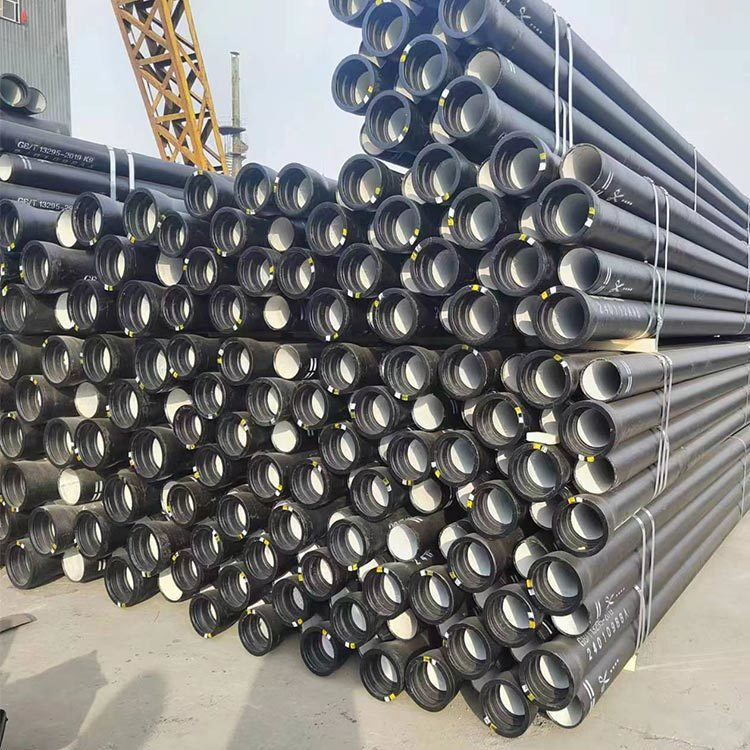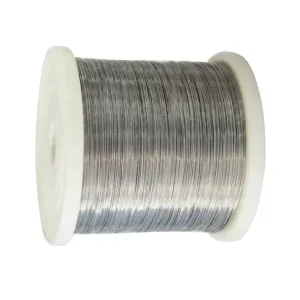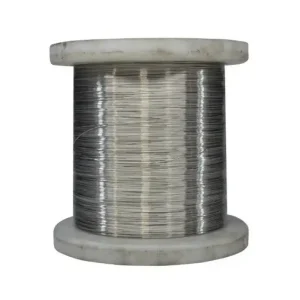We at MWalloys manufacture cement‑mortar lined ductile iron pipe designed to deliver long‑lasting, reliable service in potable water, reclaimed water, and sewer applications. we apply a high‑quality cement lining in strict accordance with ANSI/AWWA C104/A21.4. Our pipes resist tuberculation, maintain a Hazen‑Williams flow coefficient of 140, and withstand temperatures up to 212 °F.
Manufacturing Standards & Materials
We adhere to ANSI/AWWA C151/A21.51 for ductile iron pipe wall thickness and ANSI/AWWA C104/A21.4 for cement‑mortar lining. The lining mixture consists of high‑grade Portland cement and silica sand, achieving a minimum cured thickness of 0.01 in (0.25 mm) on the pipe’s interior. Our process combines centrifugal application with controlled curing to ensure uniform adhesion and smooth waterways.
Cement Lined Ductile Iron Pipe Specifications
| Parameter Category | Specification | Values/Details | Standards/Notes |
|---|---|---|---|
| Basic Specifications | |||
| Nominal Diameter (DN) | Size Range | DN 80 – DN 2600 mm | Customizable per project needs |
| Effective Length | Standard/Custom | 5.5 m, 5.7 m, 6.0 m | 6m most common for bulk shipment |
| Wall Thickness Grade | Pressure Classes | K7, K8, K9, C25, C30, C40 | K9 common for high-pressure; K7 for low-pressure |
| Standards | Compliance | ISO 2531, EN 545 (water), EN 598 (sewage), GB/T 13295 | |
| Mechanical Properties | |||
| Tensile Strength (min) | Material Strength | ≥ 420 MPa | ISO 6892-1 |
| Yield Strength (min) | 0.2% Proof Stress | ≥ 300 MPa | ISO 6892-1 |
| Elongation (min) | Ductility | ≥ 10% | 50mm gauge length |
| Hardness | Surface Resistance | ≤ 230 HB | Brinell scale |
| Cement Lining | |||
| Lining Material | Primary Type | Portland Cement Mortar | Default per ISO 4179/GB/T 17457 |
| Optional Linings | Specialty Applications | Sulfate-Resistant Cement, High-Alumina Cement, Epoxy, Polyurethane | For aggressive fluids/sewage |
| Lining Thickness | Standard | ≥ 3.0 mm | ISO 4179/GB/T 17457-2019 |
| Surface Roughness (C-factor) | Hydraulic Efficiency | Hazen-Williams C = 130–140 | Comparable to epoxy/polyurethane in long-term flow |
| External Protection | |||
| Zinc Coating | Metallurgical Bond | ≥ 130 g/m² | ISO 8179 |
| Bituminous Paint | Top Layer | ≥ 70 μm | Anti-corrosion |
| Optional Coatings | Enhanced Protection | Epoxy, Polyurethane, Zinc-Aluminum Alloy | For acidic/contaminated soils |
| Joints & Connections | |||
| Joint Types | Sealing Options | T-type (Push-on), K-type (Mechanical), Flanged, Self-Anchored | ISO 2531/EN 545 |
| Gasket Materials | Elasticity & Durability | NBR, SBR, EPDM Rubber | ISO 4633-certified |
| Testing & Certification | |||
| Hydrostatic Test Pressure | Factory Verification | 5.0 MPa (min) | 2× working pressure |
| Lining Adhesion Test | Quality Control | No cracking/spalling after impact | GB/T 17457-2019 |
| Certifications | Global Compliance | ISO, EN, CE, GB/T | Third-party audited |
| Performance & Lifespan | |||
| Design Working Pressure | Max. Operating | K7: ≤1.0 MPa; K9: ≤3.5 MPa | Pressure class-dependent |
| Temperature Tolerance | Operational Range | -30°C to +60°C | |
| Service Life | With Proper Installation | ≥ 100 years | Cement lining slows corrosion |
Cement Lined Ductile Iron Pipe Sizes
| Nominal Diameter (DN) | Outside Diameter (OD) (mm) | Wall Thickness (K-Class) (mm) | Cement Lining Thickness (mm) (Min) | Standard Length (m) | Approximate Weight (kg/m) (incl. lining) | Approx. Water Capacity (L/m) |
| 80 | 98 | K9: 6.0 | 3 | 6 or 5.5 | 9.8 | 5.0 |
| 100 | 118 | K9: 6.0 | 3 | 6 or 5.5 | 12.2 | 7.8 |
| 150 | 170 | K9: 6.0 | 4 | 6 or 5.5 | 20.2 | 17.7 |
| 200 | 222 | K9: 6.3 | 4 | 6 or 5.5 | 29.5 | 31.4 |
| 250 | 274 | K9: 6.8 | 5 | 6 or 5.5 | 41.3 | 49.1 |
| 300 | 326 | K9: 7.2 | 5 | 6 or 5.5 | 55.0 | 70.7 |
| 350 | 378 | K9: 7.7 | 6 | 6 or 5.5 | 70.8 | 96.2 |
| 400 | 429 | K9: 8.1 | 6 | 6 or 5.5 | 87.8 | 125.7 |
| 450 | 480 | K9: 8.6 | 7 | 6 or 5.5 | 106.9 | 159.0 |
| 500 | 531 | K9: 9.0 | 7 | 6 or 5.5 | 126.9 | 196.3 |
| 600 | 633 | K9: 9.9 | 8 | 6 or 5.5 | 174.9 | 282.7 |
| 700 | 735 | K9: 10.8 | 9 | 6 or 5.5 | 229.4 | 384.8 |
| 800 | 837 | K9: 11.7 | 10 | 6 or 5.5 | 290.7 | 502.7 |
| 900 | 939 | K9: 12.6 | 11 | 6 or 5.5 | 359.8 | 636.2 |
| 1000 | 1041 | K9: 13.5 | 12 | 6 or 5.5 | 438.4 | 785.4 |
| 1200 | 1245 | K9: 15.3 | 14 | 6 or 5.5 | 610.8 | 1131.0 |
Performance Parameters
| Parameter | Value | Test Method |
|---|---|---|
| Hazen‑Williams “C” Coefficient | 140 | Field flow tests, ages 1–3 years |
| Internal Roughness (k, mm) | 0.001 | ASTM D2190 |
| Operating Pressure (psi) | Up to 350 | AWWA C150/A21.50 |
| Temperature Range | 32 °F to 212 °F | ANSI/AWWA C104/A21.4 |
| Adhesion Strength (psi) | ≥ 300 | ASTM C297 |
Global Price Comparison
| Region | Price per Meter (USD) | Source & Date |
|---|---|---|
| China | 75–85 | MarketReport 2024 (July 2024) |
| India | 70–80 | GlobalWaterTrade Q2 2024 |
| United States | 120–130 | U.S. Engineering News Record Jan 2025 |
| Europe | 100–110 | European Pipe Association 2024 |
Comparative Advantage Analysis
We outperform alternative materials (e.g., PVC, HDPE) by offering:
-
Superior Structural Strength—ductile iron’s tensile strength > 60 ksi, vs. 10–30 ksi for plastics.
-
Longer Service Life—cement lining resists corrosion; service life ≥ 100 years.
-
Enhanced Flow Efficiency—internal diameter exceeds nominal, reducing head loss even vs. higher “C” PVCs.
-
Greater Temperature & Pressure Tolerance—usable up to 212 °F and 350 psi, vs. 140 °F and 150 psi for plastics.
Application Scenarios
-
Municipal Water Distribution: potable systems requiring NSF 61 compliance.
-
Wastewater & Reclaimed Water: cement lining resists biological growth.
-
Fire Protection: high‑pressure systems benefit from ductile iron’s robustness.
-
Industrial Process Water: pipelines exposed to varying pH and suspended solids.
Installation & Technical Guidelines
-
Trench Preparation: embed pipe on uniform bedding (AASHTO Class II).
-
Joint Assembly: use push‑on or mechanical joint per ANSI/AWWA C111/A21.11.
-
Bed & Cover: 6 inches of selected backfill under pipe, then side fill in 6 in lifts.
-
Hydrostatic Testing: test to 1.5× design pressure for 2 hours.
-
Disinfection: flush with chlorinated water per AWWA C651.
Frequently Asked Questions
What is the primary benefit of the cement lining in your ductile iron pipes?
The primary benefit of the cement mortar lining is twofold: it provides superior internal corrosion protection and maintains excellent hydraulic efficiency over the pipe's incredibly long service life. By creating a barrier between the water and the iron, it prevents tuberculation (rust buildup) and guards against various chemical attacks, which preserves water quality and ensures the pipe's internal diameter remains clear for consistent flow without increased pumping costs. Without it, metallic pipes can suffer significant flow reduction over time due to internal scaling and corrosion.
Is the cement lining safe for conveying potable (drinking) water?
Absolutely, yes. The cement mortar lining used in MWalloys' ductile iron pipes is specifically formulated from materials that are inert and non-toxic. We ensure our lining materials and application processes comply with the most stringent international standards for materials in contact with drinking water, such as NSF/ANSI 61 in North America and relevant European and global health regulations. This guarantees that the lining will not impart any taste, odor, or harmful substances into the water.
How does cement-lined ductile iron pipe perform in aggressive soil conditions?
Our cement-lined ductile iron pipes are exceptionally robust in aggressive soil conditions due to their multi-layered external protection system. This typically includes an initial metallic zinc coating, which provides active galvanic corrosion protection, followed by a bituminous or epoxy topcoat that acts as a passive barrier. For particularly aggressive or unknown soil conditions, we often recommend supplementary protection, such as polyethylene encasement (polywrap), which offers an additional, highly effective passive barrier. When properly protected, these pipes have demonstrated remarkable longevity even in challenging environments.
What is the expected service life of MWalloys' cement-lined ductile iron pipe?
Ductile iron pipes are renowned for their incredible longevity. With proper installation and the comprehensive internal cement lining and external corrosion protection systems that MWalloys provides, our pipes have an expected service life of 100 years or more. Historical data from installations worldwide dating back to the mid-20th century, and even earlier for gray cast iron, consistently demonstrate this extended durability. This long lifespan translates directly into reduced lifecycle costs and a sustainable infrastructure solution.
Can your cement-lined ductile iron pipes be installed in seismic zones or areas with ground movement?
Yes, absolutely. The inherent ductility and flexibility of ductile iron, combined with the flexible nature of our push-on gasketed joints, make our pipes highly suitable for installation in seismic zones or areas prone to ground movement and differential settlement. Unlike rigid piping materials that can fracture, ductile iron pipes can accommodate significant deflection and strain without compromising their integrity or leak-tightness. This "system flexibility" is a key advantage for resilient infrastructure.
How does the total cost of ownership (TCO) for cement-lined ductile iron pipe compare to other pipe materials?
While the initial purchase price of cement-lined ductile iron pipe might be higher than some plastic alternatives like PVC or HDPE, its total cost of ownership (TCO) is often significantly lower over the pipeline's lifecycle. This is due to several factors: its exceptional longevity (100+ years vs. 50 years or less for some alternatives), minimal maintenance requirements, superior resistance to damage during installation and operation, and consistently high hydraulic efficiency. When you factor in fewer leaks, reduced repair costs, and sustained flow rates over decades, the long-term economic benefits of ductile iron become overwhelmingly clear.

